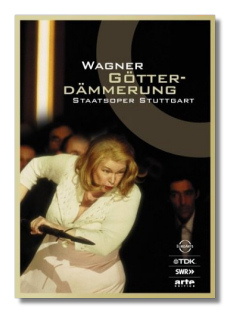
The Internet's Premier Classical Music Source
Related Links
- Wagner Reviews
- Latest Reviews
- More Reviews
-
By Composer
-
Collections
DVD & Blu-ray
Books
Concert Reviews
Articles/Interviews
Software
Audio
Search Amazon
Recommended Links
Site News
 DVD Review
DVD Review
Richard Wagner

Götterdämmerung
- Siegfried: Albert Bonnema
- Gunther: Hernan Iturraide
- Alberich: Franz-Joseph Kappelmann
- Hagen: Roland Brecht
- Brünnhilde: Luana DeVol
- Gutrune: Eva-Maria Westbroek
- Waltraute: Tichina Vaughn
- 1st Norn: Janet Collins
- 2nd Norn: Lani Poulson
- 3rd Norn: Sue Patchell
- Woglinde: Helga-Rós Indridadóttir
- Wellgunde: Sarah Castle
- Floshilde: Janet Collins
Stuttgart State Opera Orchestra & Chorus/Lothar Zagrosek
Stage Direction: Peter Konwitschny
Stage and Costume Designer: Bert Neumann
Dramaturgy: Julianne Votteler
TV and Video Direction: Hans Hulscher
Producer: Dieter Schickling
Recorded live at the Staatsoper Stuttgart, 3rd October 2002 and 12th January 2003
EuroArts TDK DVOPRDNG 105209-9 2DVDs Dolby Digital 5.1; DTS 5.1; LPCM Stereo 16.9
Anamorphic Wide Screen
Those who have been following this Stuttgart State Opera/Wagner Ring cycle will know that the staging here of Götterdämmerung will, to say the least, stir controversy. I have previously covered Das Rheingold and Siegfried in this EuroArts series, but somehow missed Die Walküre. Like Rheingold and Siegfried (and probably like Die Walküre) Götterdämmerung is given an updated treatment – well, a mostly updated treatment (more about this aspect later).
One has to wonder if stage director Peter Konwitschny and producer Dieter Schickling set out to mock operatic conventions, especially with regard to lavish production values. Here the sets and props are deliberately barren and rudimentary; moreover, stage action is often crudely sophomoric: when Siegfried departs on his Rhine journey in the Prologue, Brünnhilde merely lifts up the canvas containing the background mountain scenery for him to walk under. In another scene – the opening one in fact, the three Norns are dressed to appear as bag ladies, obviously to reflect their 'homeless' status.
Most characters, as in the Rheingold and Siegfried productions, are attired in 21st century garb, the males all looking like businessmen. The exceptions are Siegfried, who at the beginning is dressed like a cave man; Brünnhilde, who is generally attired in long dresses; Alberich and the Rhine maidens; and Waltraute, who could probably pass for a proper, Wagner-era Waltraute, even if she is lowered onto the stage by big cables that a blind man could see from the back rows (again, apparently, to show disdain for high-minded – or even for normal – production values).
One curious event occurs near the end of the opera, just before Brünnhilde's Immolation scene: first Gunther and then Siegfried come back to life, only to leave the stage! Actually, there is another surprise at the end, but maybe I've already revealed too much. At any rate, for all its unconventional staging features, for all its sass and anachronisms, the performance works, at least for me. The singers, while not always exciting or inspiring, are generally quite good. I liked Albert Bonnema as Siegfried and Roland Brecht as Hagen, both being effective actors and fine singers. Luana DeVol is good as Brünnhilde too, despite a tendency to be overly grim-faced at times. Eva-Maria Westbroek is also quite convincing as Gutrune.
But, as in the other productions in this series, the real star is conductor Lothar Zagrosek, whose grasp of tempos and shaping of the score are always incisive, and who manages to draw excellent playing from his Stuttgart forces. The sound is fine, too. As with Rheingold and Siegfried, the bottom line here is, if you are open to a different approach to Wagner, you should find this DVD quite compelling. Traditional Wagnerians will probably choose to avoid it.
Copyright © 2004, Robert Cummings


















